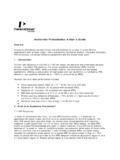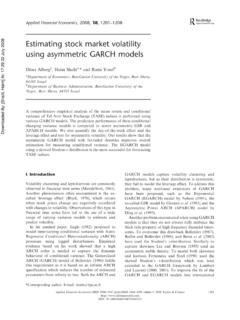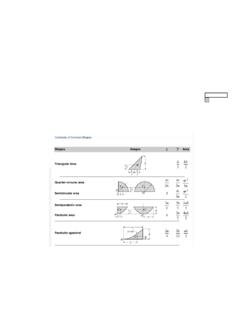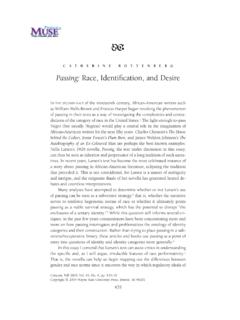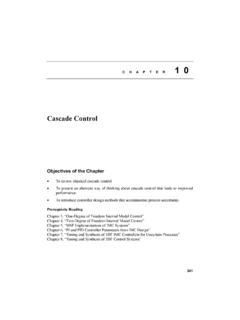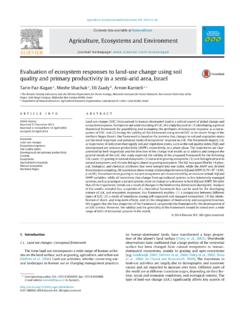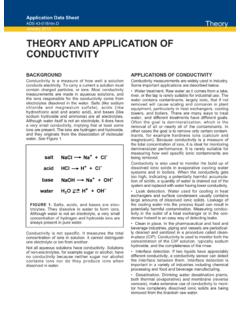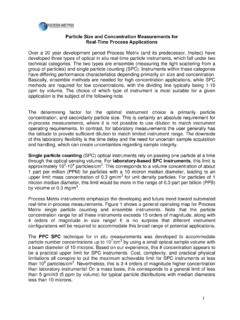Transcription of CHAPTER 3 Two-Dimensional Problems in Elasticity
1 95 CHAPTER 3 Two-Dimensional Problems in has been pointed out in Sec. , the approaches in widespread use for determin-ing the influence of applied loads on elastic bodies are the mechanics of materialsor elementary theory(also known as technical theory) and the theory of must rely on the conditions of equilibrium and make use of a relationship be-tween stress and strain that is usually considered to be associated with elastic mate-rials. The essential difference between these methods lies in the extent to which thestrain is described and in the types of simplifications mechanics of materials approach uses an assumed deformation mode orstrain distribution in the body as a whole and hence yields the averagestress at asection under a given loading. Moreover, it usually treats separately each simpletype of complex loading, for example, axial centric, bending, or torsion.
2 Although ofpractical importance, the formulas of the mechanics of materials are best suited forrelatively slender members and are derived on the basis of very restrictive condi-tions. On the other hand, the method of Elasticity does not rely on a prescribed de-formation mode and deals with the general equations to be satisfied by a body inequilibrium under any external force theory of Elasticity is preferred when critical design constraints such asminimum weight, minimum cost, or high reliability dictate more exact treatment orwhen prior experience is limited and intuition does not serve adequately to supplythe needed simplifications with any degree of assurance. If properly applied, thetheory of Elasticity should yield solutions more closely approximating the actualdistribution of strain, stress, and , Elasticity theory provides a check on the limitations of the mechanics ofmaterials solutions.
3 We emphasize, however, that both techniques cited are approxi-mations of nature, each of considerable value and each supplementing the 12/20/02 7:20 AM Page 9596 CHAPTER 3 Two-Dimensional Problems in ElasticityThe influences of material anisotropy, the extent to which boundary conditions de-part from reality, and numerous other factors all contribute to PRINCIPLES OF ANALYSISTo ascertain the distribution of stress, strain, and displacement within an elasticbody subject to a prescribed system of forces requires consideration of a number ofconditions relating to certain physical laws, material properties, and fundamental principles of analysis, also referred to as the three aspects ofsolid mechanics Problems , are summarized as of equations of statics must be satisfied throughoutthe strain properties (constitutive relations, for example,Hooke s law) must comply with the known behavior of the material of geometry of deformation and the distributionof strain must be consistent with the preservation of body continuity.
4 (The mat-ter of compatibility is not always broached in mechanics of materials analysis.)In addition, the stress, strain, and displacement fields must be such as to conform tothe conditions of loading imposed at the boundaries. This is known as satisfying theboundary conditionsfor a particular problem . If the problem is dynamic, the equa-tions of equilibrium become the more general conservation of momentum; conser-vation of energy may be a further conditions described, and stated mathematically in the previous chapters,are used to derive the equations of Elasticity . In the case of a three-dimensionalproblem in Elasticity , it is required that the following 15 quantities be ascertained:six stress components, six strain components, and three displacement components must satisfy 15 governing equations throughout the body in ad-dition to the boundary conditions: three equations of equilibrium, six stress strainrelations, and six strain displacement relations.
5 Note that the equations of compati-bility are derived from the strain displacement relations, which are already in-cluded in the preceding description. Thus, if the 15 expressions are satisfied, theequations of compatibility will also be satisfied. Three- dimensional Problems inelasticity are often very complex. It may not always be possible to use the directmethod of solution in treating the general equations and given boundary condi-tions. Only a useful indirect method of solution will be presented in Secs. many engineering applications, ample justification may be found for simpli-fying assumptions with respect to the state of strain and stress. Of special impor-tance, because of the resulting decrease in complexity, are those reducing athree- dimensional problem to one involving only two dimensions. In this regard, weshall discuss throughout the text various plane strain and plane stress CHAPTER is subdivided into two parts.
6 In Part A, derivations of the govern-ing differential equations and various approaches for solution of two-dimensionalproblems in Cartesian and polar coordinates are considered. Part B treats 12/20/02 7:20 AM Page Strain Problems97concentrations in members whose cross sections manifest pronounced changes andcases of load application over small A Formulation and Methods of STRAIN PROBLEMSC onsider a long prismatic member subject to lateral loading (for example, a cylin-der under pressure), held between fixed, smooth, rigid planes (Fig. ). Assumethe external force to be functions of the xand ycoordinates only. As a conse-quence, we expect all cross sections to experience identical deformation, includingthose sections near the ends. The frictionless nature of the end constraint permitsx, ydeformation, but precludes zdisplacement; that is,at Con-siderations of symmetry dictate that wmust also be zero at midspan.
7 Symmetry ar-guments can again be used to infer that at and so on, until everycross section is taken into account. For the case described, the strain depends on xand yonly:( )( )The latter expressions depend on and vanishing, since wand its deriva-tives are zero. A state of plane strain has thus been described wherein each pointremains within its transverse plane, following application of the load. We next pro-ceed to develop the equations governing the behavior of bodies under of into Eq. ( ) provides the followingstress strain relationships: z= yz= xz=00v/0z0u/0z z=0w0z=0, xz=0w0x+0u0z=0, yz=0w0y+0v0z=0 x=0u0x, y=0v0y, xy=0u0y+0v0x;L/4,w=0z=; strain in a 12/20/02 7:20 AM Page 9798 CHAPTER 3 Two-Dimensional Problems in Elasticity ( )and( )Because is not contained in the other governing expressions for plane strain, it isdetermined independently by applying Eq. ( ).
8 The strain stress relations, Eqs.( ), for this case become( )Inasmuch as these stress components are functions of xand yonly, the first twoequations of ( ) yield the following equations of equilibriumof plane strain:( )The third equation of ( ) is satisfied if In the case of plane strain, there-fore, no body force in the axial direction can similar restriction is imposed on the surface forces. That is, plane strain willresult in a prismatic body if the surface forces and are each functions of xandyand On the lateral surface,(Fig. ). The boundary conditions,from the first two equations of ( ), are thus given by( )Clearly, the last equation of ( ) is also the case of a plane strain problem , therefore,eight quantities,and , must be determined so as to satisfy Eqs. ( ), ( ), and ( ) andvu, xy, y, x, xy, y, x, py= xyl+ ym px= xl+ xymn=0pz= 0 y0y+0 xy0x+Fy=0 0 x0x+0 xy0y+Fx=0 xy= xyG y=1- 2E y- 1- x x=1- 2E x- 1- y z xz= yz=0, z= 1 x+ y2= 1 x+ y2 xy=G xy y=2 G y+ 1 x+ y2 x=2 G x+ 1 x+ 12/20/02 7:20 AM Page Stress Problems99the boundary conditions ( ).
9 How eight governing equations, ( ), ( ), and( ), may be reduced to three is now for Two-Dimensional strain at a point [Eq. ( )] are func-tions of only twodisplacements,uand , and therefore a compatibility relationshipexists among the strains [Eq. ( )]:( )This equation must be satisfied for the strain components to be related to the dis-placements as in Eqs. ( ). The condition as expressed by Eq. ( ) may be trans-formed into one involving components of stress by substituting the strain stressrelations and employing the equations of equilibrium. Performing the operationsindicated, using Eqs. ( ) and ( ), we have(a)Next, the first and second equations of ( ) are differentiated with respect to xandy, respectively, and added to yieldFinally, substitution of this into Eq. (a) results in( )This is the equation of compatibilityin terms of now have three expressions, Eqs. ( ) and ( ), in terms of three unknownquantities:and This set of equations, together with the boundary condi-tions ( ), is used in the solution of plane strain Problems .
10 For a given situation,after determining the stress, Eqs. ( ) and ( ) yield the strain and displacement,respectively. In Sec. , Eqs. ( ) and ( ) will further be reduced to one equationcontaining a single STRESS PROBLEMSIn many Problems of practical importance, the stress condition is one of planestress. The basic definition of this state of stress has already been given in Sec. this section we shall present the governing equations for the solution of planestress exemplify the case of plane stress, consider a thin plate, as in Fig. ,wherein the loading is uniformly distributed over the thickness, parallel to theplane of the plate. This geometry contrasts with that of the long prism previouslydiscussed, which is in a state of plane strain. To arrive at tentative conclusions withregard to the stress within the plate, consider the fact that and are zero yz xz, z, xy.

